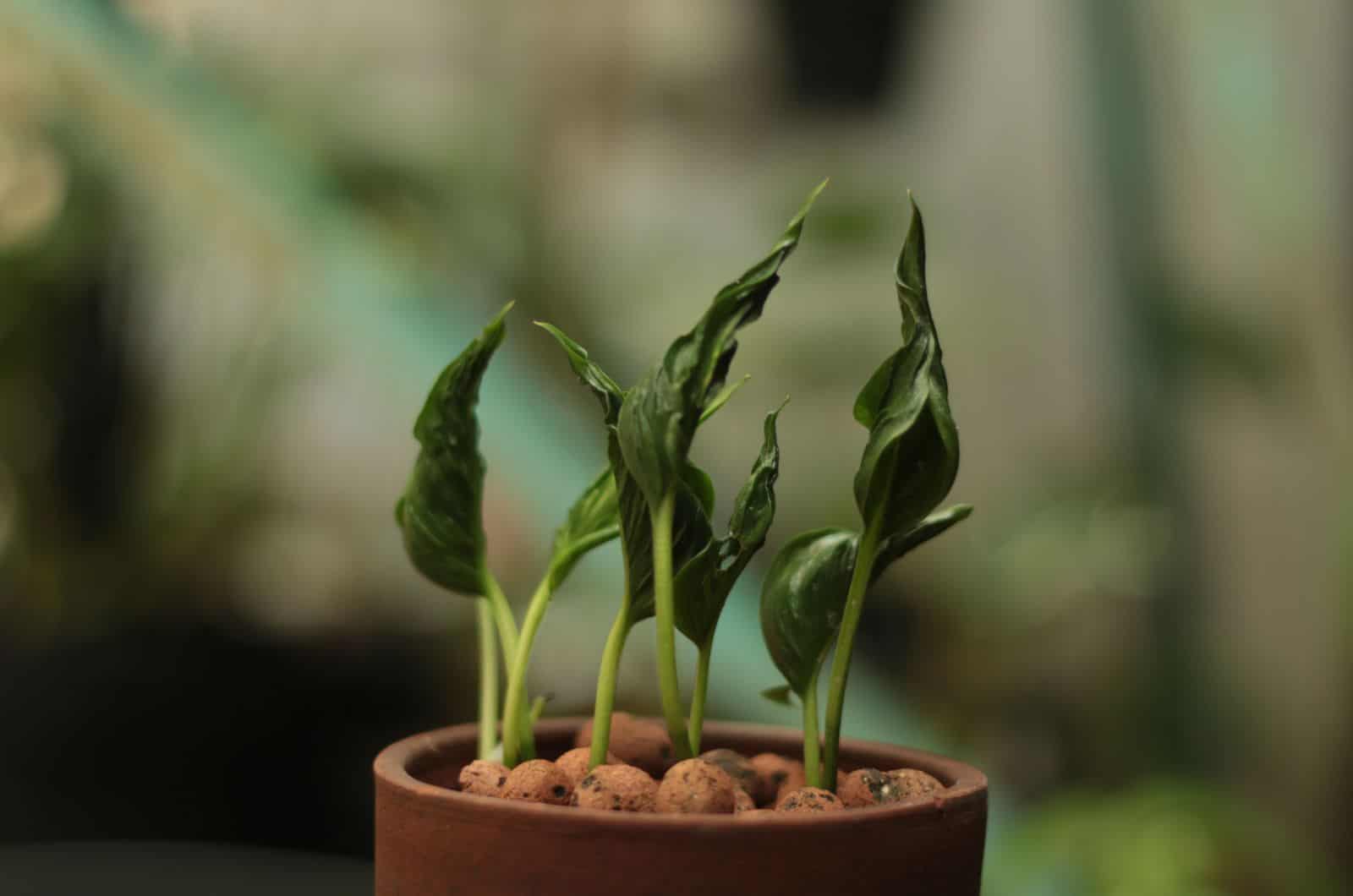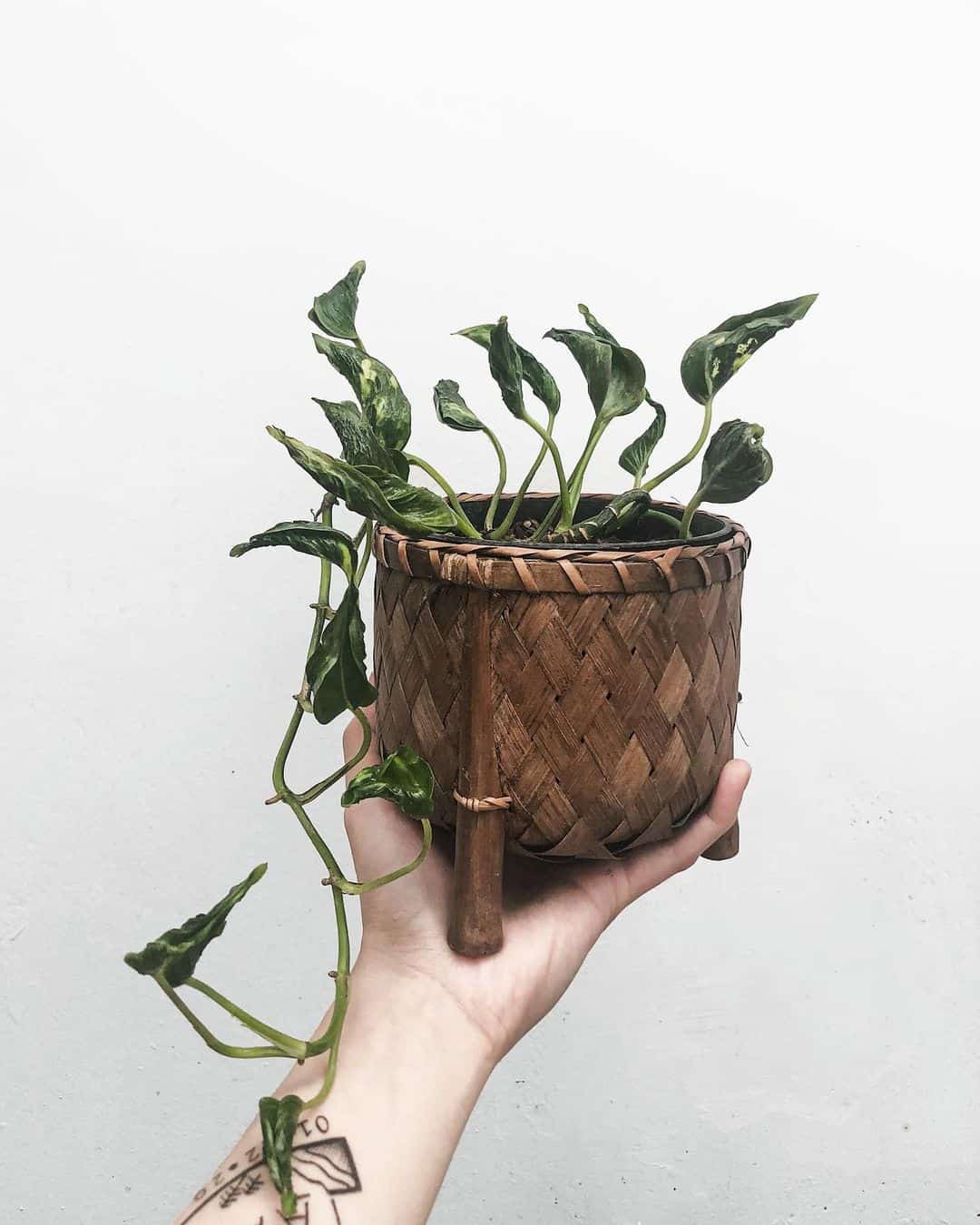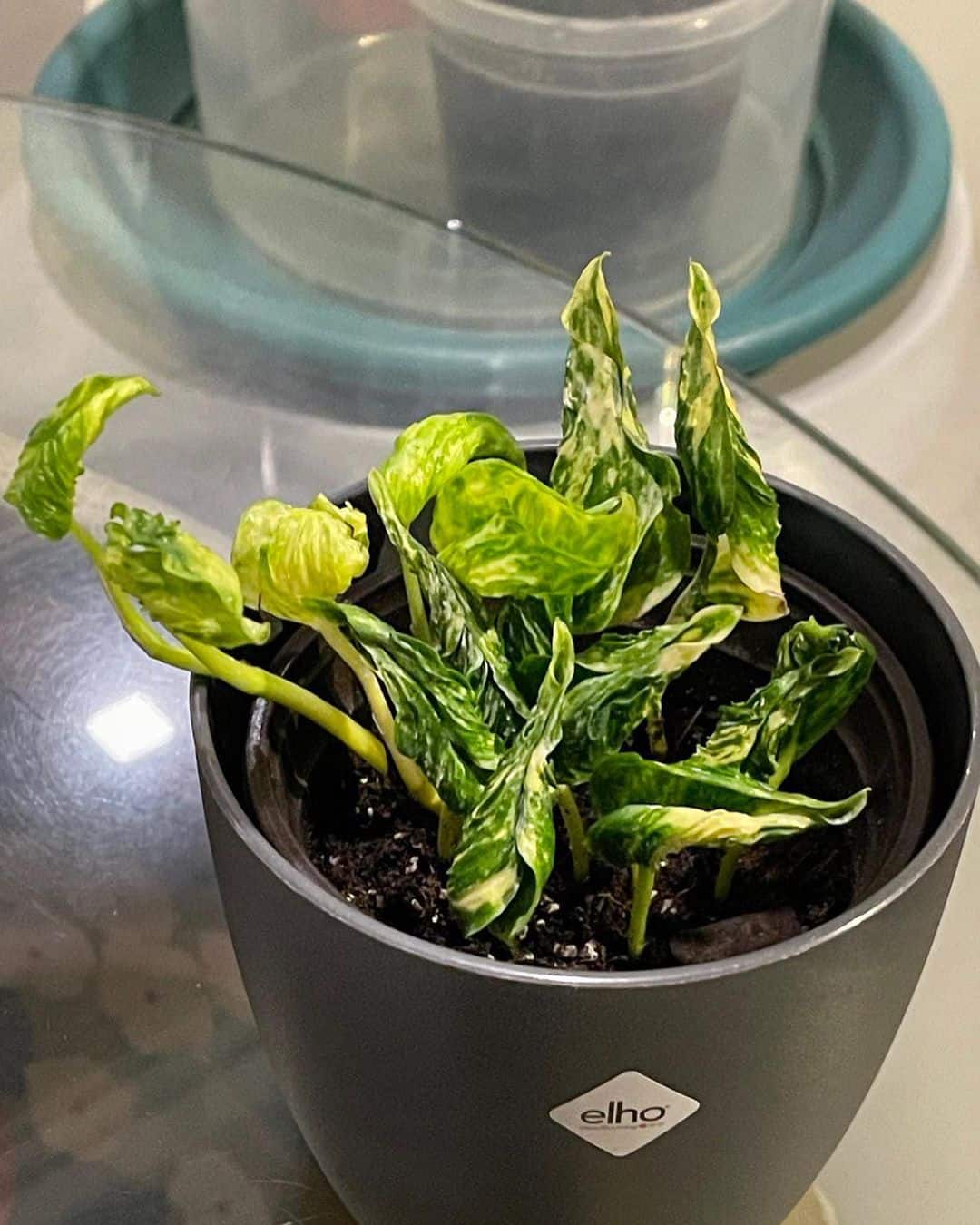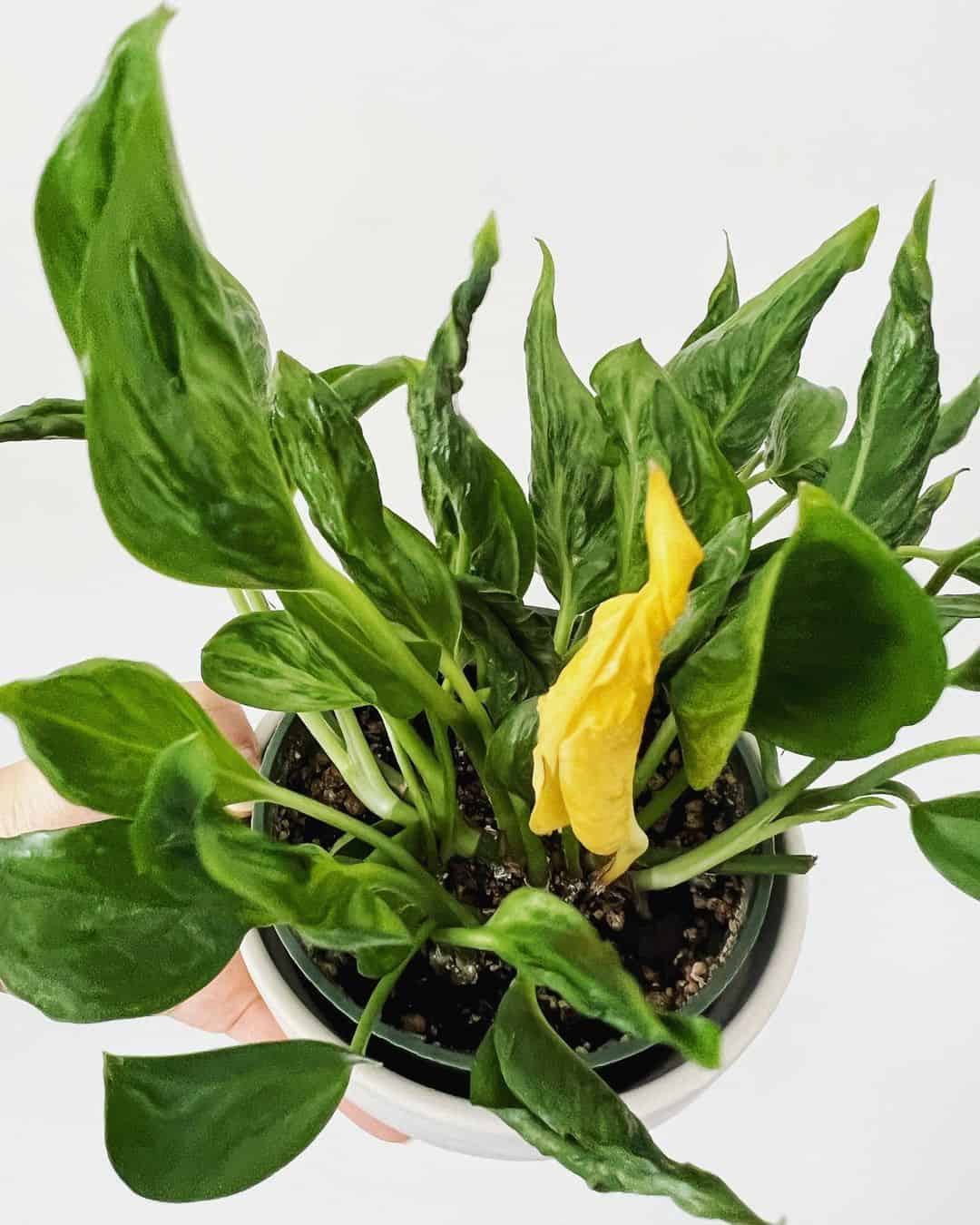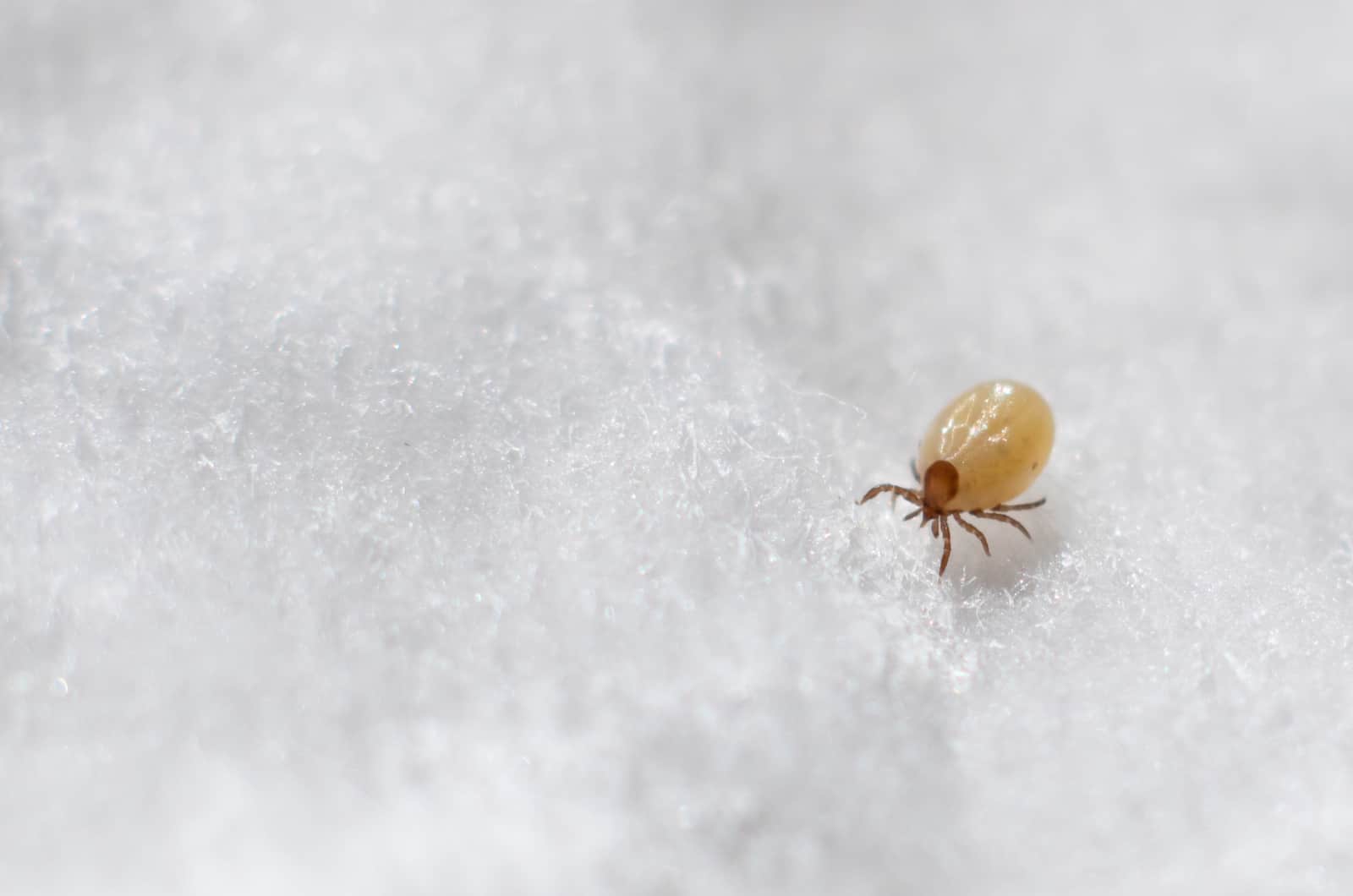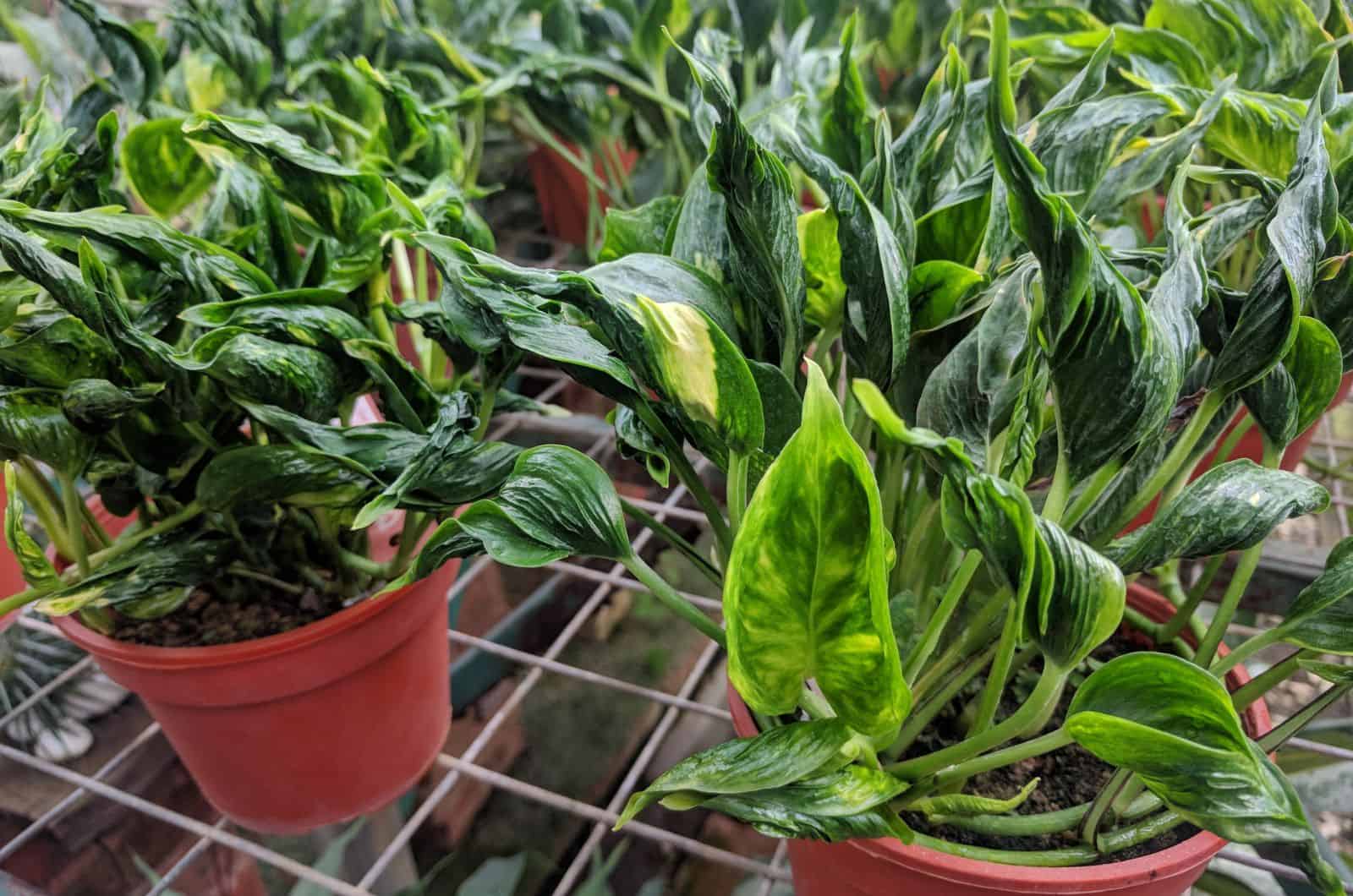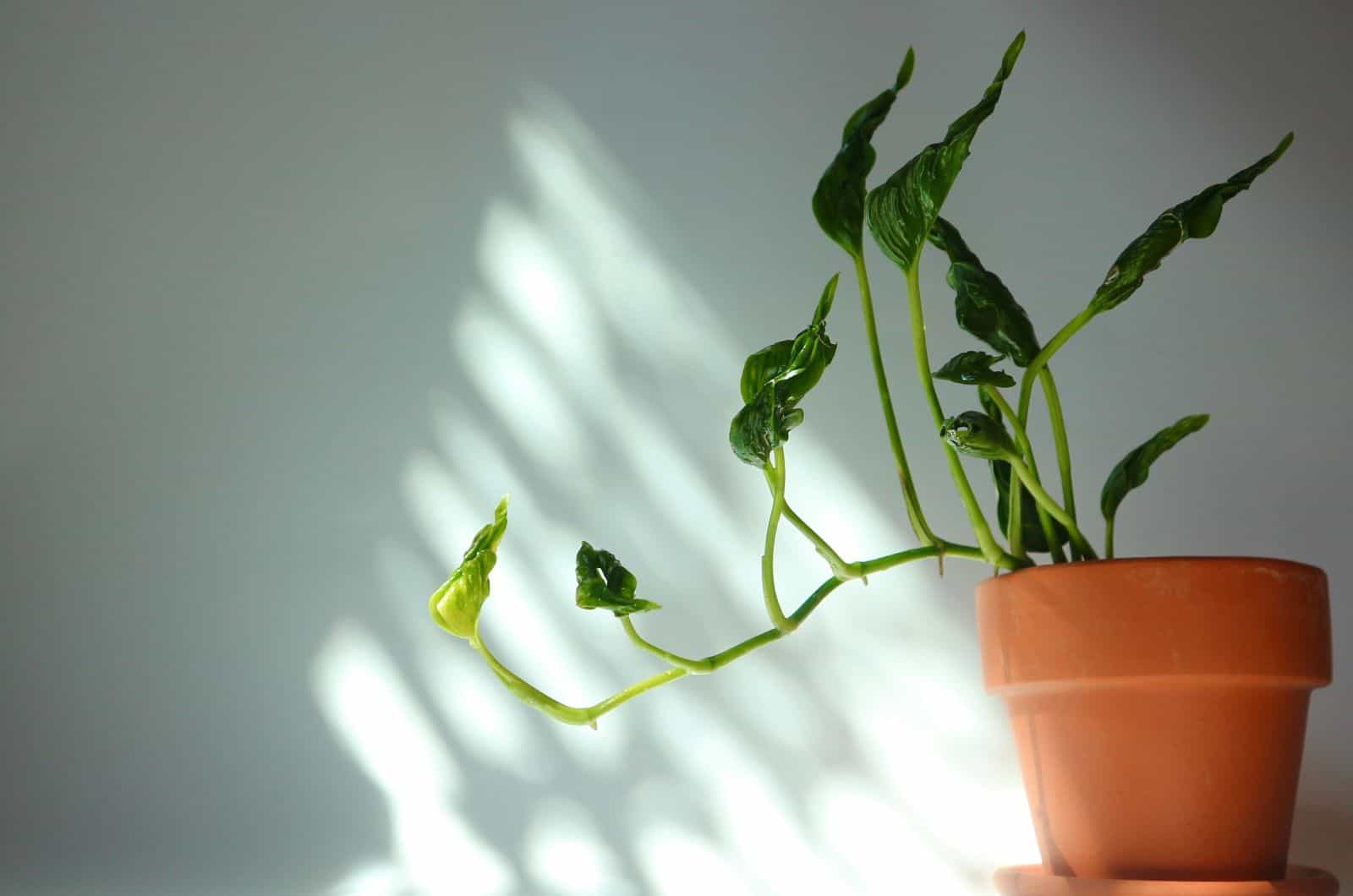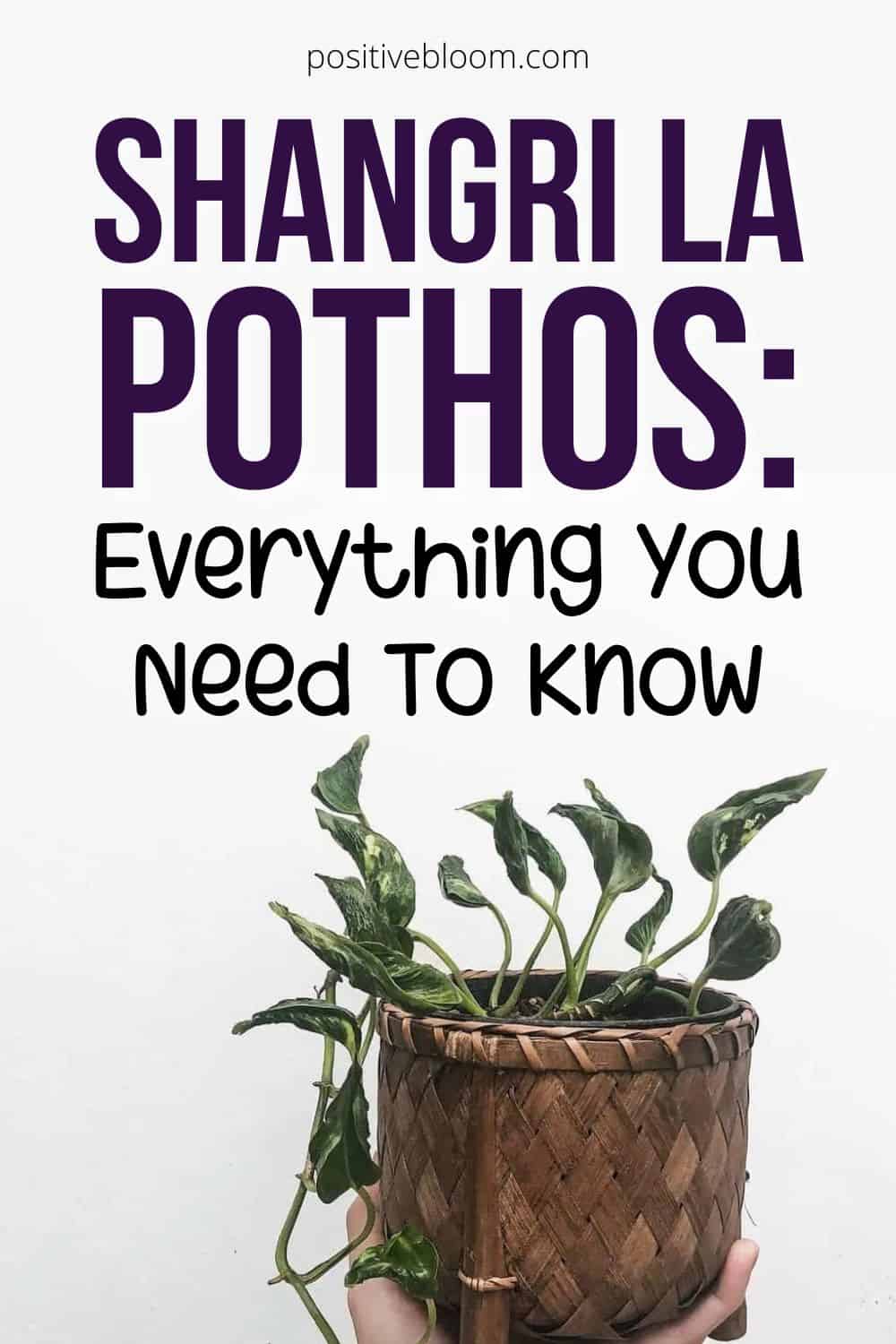Pothos plants are really popular and adorn many homes around the world, so it’s no wonder people are always discovering new species!
The Shangri La pothos is one of the varieties that’s been cultivated for its beauty, but that doesn’t make it any less attractive than the species and types that occur naturally.
Its care guide is quite similar to that of other pothos plants, and this cultivar is also affected by the same pests and diseases.
We’ll discuss all these issues in this article and also present some interesting facts about the Shangri pothos, including its origin, main features, and toxicity.
Before we start, let’s look into the main specifics of this plant:
[table id=294 /]Shangri La Pothos Care Guide
How to grow trailing pothos is simply a matter of following their care guide and getting them something to trail on.
The Shangri La pothos care guide is no different; you have to ensure it gets proper lighting, water it when the soil feels dry, provide soil with good drainage, and some nutrients.
There are also some other things like repotting and pruning you can do to get this plant back to its full glory.
We’ll teach you everything you need to know to help your pothos Shangri La thrive.
Let’s get started!
Light Requirements
Photo from: @mskarina.so
Just like any other aroid, pothos species require bright indirect light. The need for these lighting conditions is evolutionary and comes from the fact that the native habitat of this plant, and the species it belongs to, are rainforests that don’t get enough sunlight.
This means the Shangri La adjusted to somewhat low-light conditions, but that still doesn’t mean you should grow it in the dark!
Lack of sunlight causes legginess and loss of variegation and makes your plant ordinary (Who wants that for their green buddy?).
Protect your plant from the direct sunlight, but also provide it with filtered light to help it flourish.
You can place it near an east or south-facing window where it can safely bask in the mild morning or evening sun.
If your apartment faces north and doesn’t get enough natural sun, you can always turn to grow lights to provide photosynthesis and keep your plant healthy.
Water And Humidity
The Pothos Shangri La is a tropical plant, and it’s a common gardening mistake to give these plants more water than they actually need.
The soil doesn’t have to be soaking wet for this plant to survive, in fact, overwatering can even lead to root rot, which can kill your plant if not caught in time.
Therefore, you must always irrigate your plant once the top few inches of the soil are dry, which might be once a week during the growing season and every other week after the plant enters dormancy.
Of course, you’ll need to water the plant more frequently during hot, arid summers, so keep your watering can ready!
An underwatered pothos is also an issue, so don’t neglect watering your Shangri La.
Some common symptoms of an underwatered pothos plant include droopiness and shriveled leaves, which may be a bit harder to recognize in this plant as its leaves are naturally curly.
Luckily, you can always check the soil for dryness, whether the leaves have changed color, or if some brown spots have appeared.
However, watering shouldn’t be the only source of moisture for this climber; humidity is also important.
Humidity
Something often forgotten by beginner growers is the humidity requirements of their plants. Issues like curly leaves and brown tips can be solved by raising the air moisture around plants.
This particular pothos variety requires relative humidity above 50%, so you should increase it in order to get the best growing conditions for your plant.
There are several ways to increase air moisture, and we’ll discuss some of them below:
Humidifier
Using humidifiers to raise the humidity level for your Shangri La is one of the best and safest ways of raising air moisture.
You can simply turn it on and enjoy your healthy plant without worrying about powdery mildew, leaf spot, or some other disease caused by excess moisture on its leaves.
Misting
Spraying your plants with water from time to time is an effective way to keep them hydrated.
You should mist your plants every couple of days in order to avoid wet leaves, on which bacteria and fungi can multiply.
Pebble Tray Method
Humidity trays are easy to assemble; all you need is some small rocks, gravel, or pebbles, a tray, and some water.
Simply fill the tray with pebbles and water and place your potted plant on it.
There’s been much discussion about this method and whether it actually works, and the answer is (unfortunately) yes and no.
It does work for smaller plants because the moisture that evaporates from the tray can reach the nearby leaves. However, water vapor disperses before it reaches the leaves of tall plants, so it doesn’t have much effect on them.
A humidifier is effective, simple, and doesn’t mess with interior design.
Grouping Plants
Moving plants and placing them together is another method that works, but it doesn’t drastically raise humidity levels.
If you live in an arid region where household humidity doesn’t exceed 30%, this method wouldn’t be of much use on its own.
Even though the nearby plants trap moisture that leaves the other plants via transpiration, it wouldn’t make much difference if they didn’t have enough water to transpire in the first place.
However, you can still move your plants close by and either mist them or turn on a humidifier to keep them hydrated.
Moving Plants To More Humid Rooms
The last method that can increase the air moisture level around your Shangri La pothos plant is moving it to a more humid room, like a kitchen or bathroom.
Your plants would be quite satisfied with the humidity level in these rooms, and you would also have a lovely companion while preparing your favorite dishes or taking a shower!
Temperature
Photo from: @saga_sequel
This houseplant loves room temperature, but anything between 60 to 85°F is fine. You shouldn’t expose it to sudden temperature changes and drafts, however, as it can stress the plant and cause it to fall into a state of shock.
Avoid drafty areas because they lower temperatures and reduce humidity levels, which causes additional issues for your plant.
Soil And Fertilizer
Even though this indoor plant is low-maintenance, you shouldn’t plant it in any old substrate.
This pothos loves fertile and well-draining soils, so use a potting mix with perlite and peat moss in it.
Even though this plant loves drainage and aeration, you shouldn’t plant it in a succulent or cactus mix as they don’t hold enough water and would deprive your pothos of one of the essential elements it needs for growth.
Fertilizer
The Pothos Shangri La isn’t a heavy feeder, so you won’t have to fertilize it very often. However, applying some plant food once a month during its growing season can help your plant grow faster and replenish the nutrients it has spent.
Also, you don’t have to fertilize this variety during winter because it enters dormancy and cannot use all the nutrients you give it during that period. However, you can feed it once during this period if you wish.
As this is a light feeder, you can simply apply compost in the early spring to make your plant happy.
If you decide on fertilizer, you can use a well-balanced, water-soluble fertilizer such as triple 10. Dilute to at least half-strength and apply it as close to the base of the plant as possible.
Finally, don’t forget to water your plant before feeding it to make the nutrients available for your plant to absorb.
Propagation
Propagation isn’t something you should be afraid to try just because you’re not sure if it will work. The first couple of times I tried propagating my plants were all disastrous, but I got the hang of it eventually!
One thing that may aid you in propagating your Shangri La are pothos aerial roots and nodes.
Propagation without nodes is not possible, and aerial roots only signify that the stem is healthy and has a high chance of success.
You can’t propagate plants through their aerial roots as you need nodes, but you can take some stem cuttings and propagate them.
Below you will find our step-by-step guide for propagating the Shangri La pothos.
Step 1. Select a healthy stem with a couple of leaves and cut it below the node. If the cutting has several leaf nodes, you can divide it into more sections – each with its own node – and propagate more plants.
Step 2. Dip the cutting(s) in rooting hormone and place them in a nursery pot filled with a starter mix.
* You can place the cutting in water instead of soil, just remove the bottom leaves so that they don’t rot and change the water every other day. You don’t have to use rooting hormones when propagating in water.
Step 3. Place the nursery pot (or a glass vessel filled with water) in indirect light and keep the substrate moist by slightly misting it whenever it feels dry. You can preserve more moisture by putting a humidity dome (or a plastic bag or wrap) over the nursery pot.
Step 4. The root system should develop in about a month, and you can check it by gently tugging the plant. The plants that have grown roots shouldn’t come out easily.
* If you have propagated your plant in water and a glass container, you can just check it occasionally and look for the transparent, worm-like parts appearing where the nodes were.
Step 5. Give your plants a couple more weeks in the same growing medium to develop stronger roots before transplanting them to a new pot. It should be one size larger than the previous one.
This will give your plant’s roots more room to grow without risking water-clogging and overwatering.
Repotting
Photo from: @green_pig_love
Pothos are fast-growing plants that should be repotted once a year (or even more frequently if they double in size).
The best time for repotting is in spring or even summer because those are the seasons when this plant actively grows. Plants experience a certain dose of shock every time they change pots and cannot uptake water or nutrients for some time after.
Repotting them well before winter can give them enough time to adjust to their new home and get over the shock before they enter dormancy.
However, there’s still a question about whether pothos plants need drainage, and the answer is yes. They need holes in the bottom of the pot for the excess water to drain and reduce the possibility of overwatering and root rot.
If you’re replanting established plants that grow on moss poles or any other alternative, you should repot them together with the stake.
Support the pole with one hand, slightly tip the pot with your other, and remove some of the soil so that you can take your plant out of the container.
Once the plant is out, move it to a new pot (one or two sizes bigger) filled halfway with a fresh potting mix. Place the plant and the pole into the container, add more soil until the stake or trellis is stable, and water the plant thoroughly.
Pruning
Trimming plants has many benefits.
For instance, diseased foliage may spread the infection onto healthy parts of the plant if you don’t remove it, so take your scissors and start snipping.
Old, discolored, wrinkly, and infected leaves have no business on your plant. They only waste energy and take up space that young and healthy leaves, able to photosynthesize, could otherwise occupy.
You can also prune this pothos plant to entice faster growth and give it a specific shape.
However, never cut more than 1/3 of the plant as that can cause damage and weaken it.
Common Issues
Pests and diseases are common culprits for dying plants, but there are certain ways to revive a pothos plant even after it gets infested or infected.
This section brings you the most common pests and diseases that may invade your pothos Shangri La so you can prevent and treat them.
The good news is that pests and diseases are more likely to affect weak plants, so following the Shangri La pothos care guide can be a great way of preventing serious issues.
Pests
The most common pests that attack pothos plants are aphids, spider mites, and mealybugs. These bugs eat your plant’s leaves and stems and drink its sap, causing it to droop.
Pest infestations may even kill your plant, which is why monitoring and dealing with infections as soon as you notice them is crucial.
Removing a bug or two isn’t difficult, and you can pick them by hand or remove them with a Q-tip dipped in rubbing alcohol if you prefer.
However, larger infestations are more dangerous and a lot more challenging to treat. You can try removing groups of pests by spraying them off your plant with a hose or placing your pothos under a stream of running water that’s strong enough to get rid of the bugs but not too harsh on the leaves and stem.
Of course, horticultural oils and pesticides are also excellent ways of treating pest infestations; just follow the instructions on the box because these products can burn your plant’s foliage!
Diseases
Root rot, powdery mildew, and leaf spot are the most common diseases that infect these plants.
Root rot is caused by overwatering, and you can prevent it by irrigating your plant only when the topsoil is dry.
However, something can always go wrong, and if you notice discolored (yellow or brown) foliage, droopiness, wilting, and stunted growth, you should check the soil. If the growing medium is soaking wet, you should take your plant out of the pot and inspect the roots.
Remove all soggy and mushy, black, brown, or dark roots, and treat the rest with a fungicide if there’s any need.
Both leaf spot and powdery mildew are caused by excess humidity and moisture on the plant’s foliage, which is why you should be very careful with misting.
If you notice small lesions or white residue on your plant’s leaves, you should isolate it from your other plants so that the diseases don’t spread.
More About The Shangri La Pothos
The Pothos Shangri La is a perfect companion to your hoya and philodendron plants as they can all create a jungle-like atmosphere within your home.
There are some more facts about this plant that you should know, and you can learn them in the sections below!
Origin And Backgrounds
The Pothos Shangri La is a cultivar of a more popular variety we’ve all heard of: the golden pothos.
This species belongs to the family Araceae, and they were first described in 1880 and were referred to as Pothos aureus. However, their name was changed in 1962 to Rhaphidophora aurea.
But the story doesn’t end there. Researchers believed it was rather similar to Epipremnum pinnatum and was commonly mistaken for this plant.
Only after examining this plant in more detail did they learn their error and reclassify it (once and for all) as Epipremnum aureum.
Still, it was only in 2004 that the botanist Peter Boyce established that their place of origin was Mo’orea Island in French Polynesia.
The pothos Shangri La has several different names, and it can thank its curly foliage for that. It is commonly known as sleeping pothos and Godzilla pothos (but it won’t destroy your town, don’t worry!).
Main Features
One of the first things that you notice about this pothos is that it is a vining plant, which means that it needs some kind of support to truly shine.
Thankfully, there are excellent ways of keeping the moss pole moist, so your plant won’t suffer from dehydration.
Another striking characteristic are the dark green, curled, and closed leaves that make this plant unique. The leaves are streaked with paler green and yellow variegations, which can make them a great addition to a modern or vintage interior design.
The Shangri La can also produce yellow-green flower spikes when grown in its natural habitat, but they don’t usually appear indoors.
Toxicity
Unfortunately, the pothos Shangri La is toxic, so you should keep it somewhere your children and pets cannot reach it.
The leaves and stems of this plant contain calcium oxalate crystals, which are harmful to humans and animals.
However, your child or pet would have to consume large quantities for the plant to be deadly, but it can still cause certain issues like ripping and tearing of the skin and mucous membrane in the stomach.
It can also cause swelling and irritation of the airways, vomiting, and excessive secretion of saliva.
Keep the plant out of reach and go to a doctor if you suspect that your child has eaten any part of this plant, or a vet if you think that your pet has treated itself to a few leaves.
Finally, always prune and repot this plant in gloves because the sap can cause skin irritation.
Common Questions
There are a couple of questions about this plant and pothos in general that need to be addressed before we end this article.
We chose a couple that you frequently asked us and will answer them in the sections below.
Is the Shangri La pothos plant rare?
No, the pothos Shangri La is not a rare plant, and you can get one for about $20-35 on Etsy and other online stores that sell plants.
What is the difference between a pothos and a philodendron?
The key difference between pothos and philodendron plants is that the former belongs to the genus Epipremnum, and the latter to the genus Philodendron.
You can recognize them by their leaf texture; pothos plants have waxier and thicker leaves than philodendrons. Also, philodendron leaves are curved inwards at the base, whereas pothos foliage is nearly straight.
You can also tell them apart by the appearance of their aerial roots. Pothoses have only one large aerial root per node, whereas philodendrons have many smaller roots for each node.
Philodendrons are usually more tolerant of low-light conditions, whereas pothos plants can last longer without any water.
Also, philodendron leaves grow from cataphylls that protect the newcomers and remain even after the new leaves unfurl and develop, but they do fall off eventually. Pothos leaves don’t develop from cataphylls; they simply grow from the older leaves.
To Wrap Up
This article included everything you need to know about the Shangri La pothos, including its care guide, common issues, and some interesting facts.
In short, these plants require indirect light, a bit of water, well-draining soil, high humidity, and fertilizer once a month (or some compost in the early summer).
They are pretty resistant, but they can still get afflicted by certain pests and diseases, although you can prevent these issues by tending to your plant’s needs.
We also included some tips on repotting, propagation, and treating your plants for infections and infestations.
We also discussed some facts about pothos Shangri La, including its origin and background, beautiful looks, variegations, and growth habits.
Finally, this plant is toxic, so we presented some common symptoms that may appear after coming into contact with the sap or eating it.
All in all, we hope you enjoy your new plant.
Until next time!
Like this post? Share or pin it for later!

